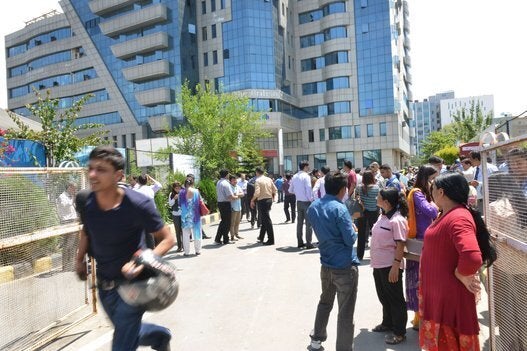Children are often able to draw traumatic experiences before they can talk about them. Nine-year-old Sanjeev shared his memories of the earthquake with staff at one of World Vision's child-friendly spaces. All images are World Vision photos.
Three months ago this weekend, the ground in Nepal shook so hard that the buildings crushed the people who were inside them. Lots of people died. The people who stayed alive became very, very sad. Life became very difficult. It was hard to stop feeling afraid.
You may want to click away at this point, thinking you've already read everything you need to know about the earthquake in Nepal. But you probably haven't heard it from the perspective of a child. And throughout the country, Nepali children whose lives were crushed by the April earthquake are trying to heal from the unthinkable.

10-year-old Sajan remembers people being very scared. An ambulance carried someone away. People were crying.
Even for adults, the experience of the Nepal earthquake is something that's tough to talk about. My World Vision Canada colleague Reena Vohra, who was in Nepal at the time of the earthquake, sat down with me this week, to share her memories. She hasn't felt ready until now. The pain and terror were still evident her voice.
"All around us, buildings were shaking and swaying," said Reena. "Pieces of debris were flying around from crumbling shops, dust was filling the air from all the fallen ancient structures. I huddled with my colleague, Gabriela, in a doorway. I remember thinking, this can't be it, my life can't be ending." But life didn't end, it continued on, full of shaking, terror and screams.

One of Reena's World Vision colleagues runs for safety. The staff tried document the devastation of what was happening in the minutes after the earthquake.
It was so hard to watch Reena go back there again as she shared her story. But even harder to imagine what it must have been like for a child. Especially if that little one had been separated from a parent, and had no understanding of what was happening.
"I can never forget a group of little children we saw just after the first earthquake," recalls Reena. "They were huddled together on the ground, crying and praying. They were clearly completely terrified."

Six-year-old Abishek has been able to speak about what happened to him that day. "My brother yelled, 'It's an earthquake' and told me to run out of the house," he recalls. "While I was running, I fell down and the stone from the walls of the house fell on my head and hit me. My head got hurt and started bleeding."

"The blood fell on my shirt," continues Abishek. "It was paining a lot, but I am a brave boy -- I didn't cry."
Many of the children my World Vision Nepal colleagues are meeting are indeed working hard to be "brave" boys and girls. In this context, bravery takes on a meaning so different from the Disney version that many Canadian children grow up with. Some children have lost parents, or other relatives close to them. Many of them are living in tents, during the weeks-long monsoon season. Schools have yet to open. Food is short. Adults are stressed.
There's no question that children are resilient, and are often able to laugh and play under seemingly impossible circumstances. But as we've learned at World Vision, they are also far more vulnerable to pain, abuse and terror than most of the adults around them. They lack the life experience and broader framework to put things in perspective. They just know that it hurts.

As part of our overall relief effort, World Vision has provided 35 child-friendly spaces and helped more than 3,500 children battle their way back from the earthquake. These are safe places where children can draw, play, and when they're ready, share their experiences of the earthquake with counselors who can help.
My colleagues are starting to see hopeful pictures, as well as tough ones. Here, 10-year-old Maiti drew a beautiful house with colourful flowers and butterflies all around it. This is her dream for the future.

We're also providing temporary learning centres, for children whose schools have been destroyed. Having a safe place to attend on a regular basis, and the routine of lessons and homework, helps provide children with stability and predictability that they need to feel comfortable.
There's no question that the many generous gifts of donors around the world -- including Canadians -- have helped Nepali children in desperate need. But they're still facing so many challenges. It's hard to see that, following the initial spate of media coverage in the weeks following the earthquake, stories have slowed to a trickle.
If Nepali children have the courage to share their stories with us, we need to keep paying attention.
Learn about how you can help children in Nepal.
MORE ON HUFFPOST:
